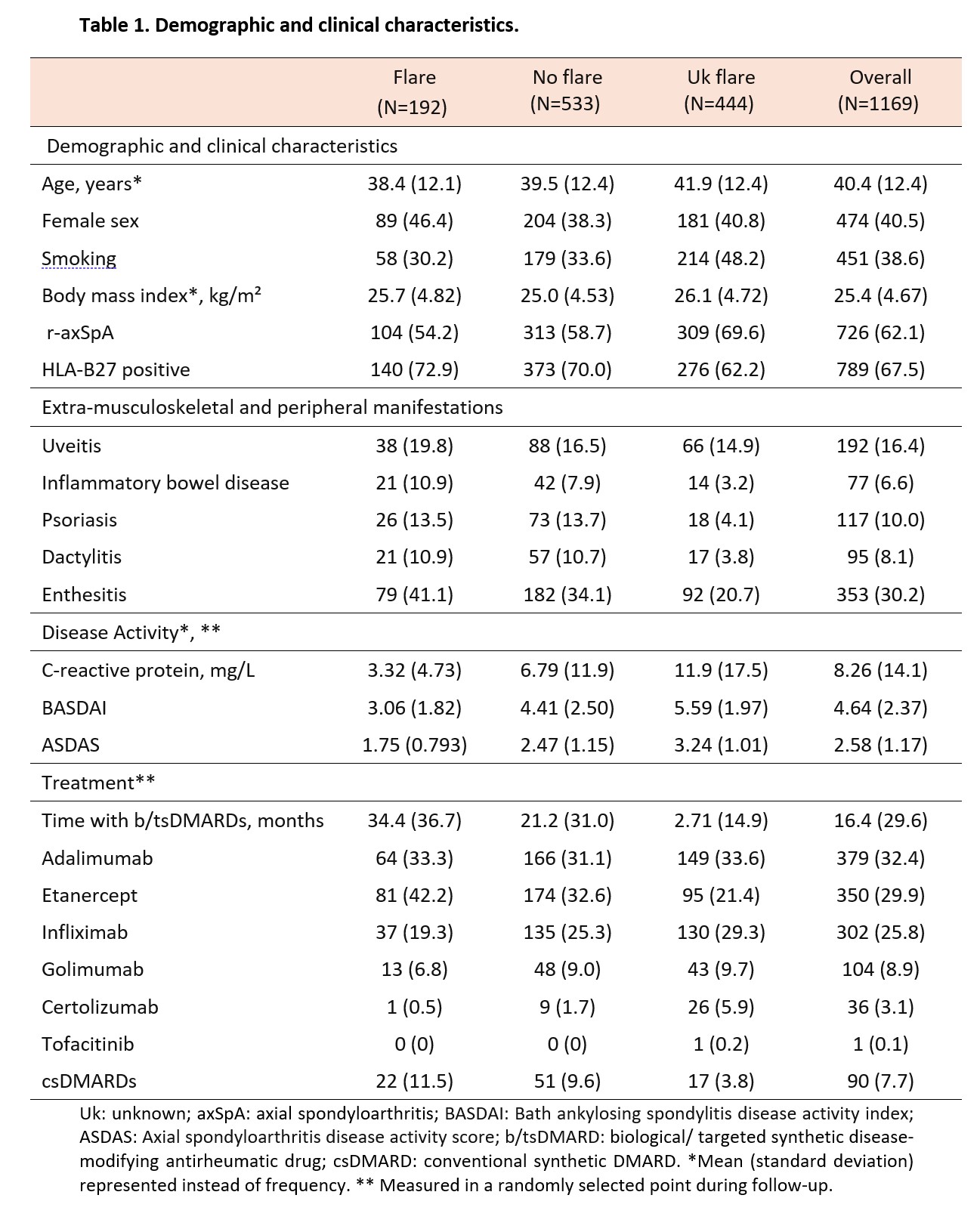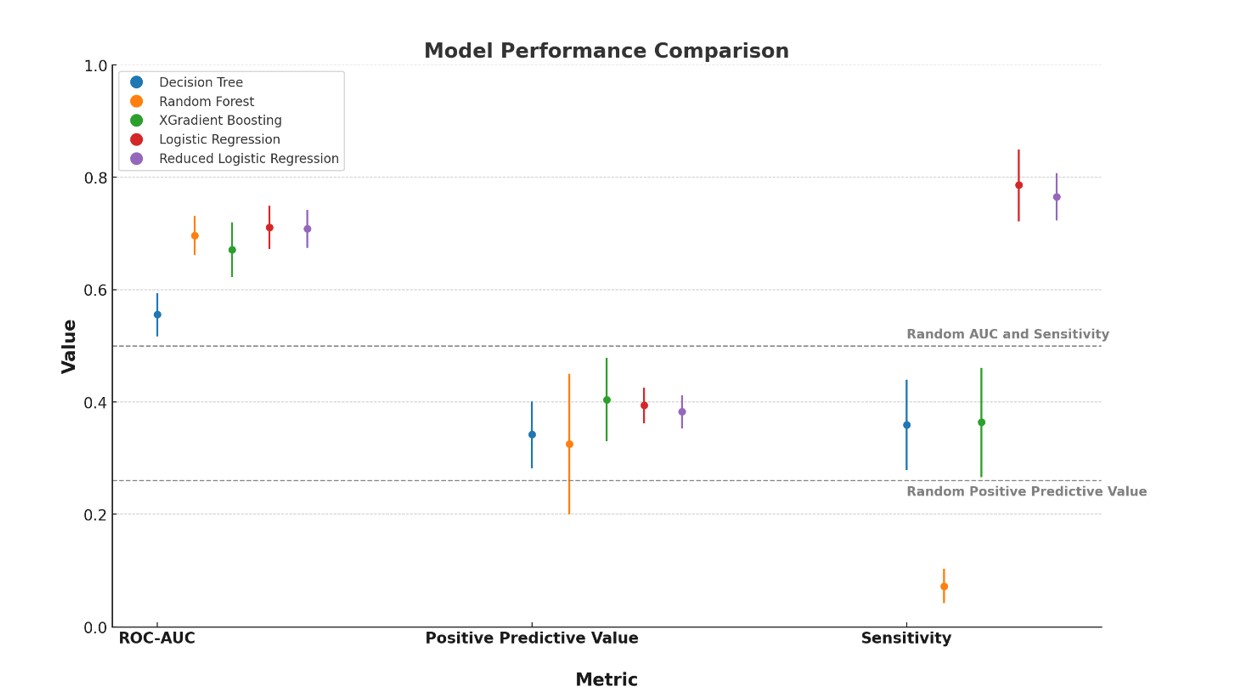Session Information
Date: Saturday, November 16, 2024
Title: SpA Including PsA – Diagnosis, Manifestations, & Outcomes Poster I
Session Type: Poster Session A
Session Time: 10:30AM-12:30PM
Background/Purpose: Patients with axial spondyloarthritis (axSpA) frequently experience unforeseen disease flares that impact their quality of life. Identification of patients with high risk of flares could improve treatment strategies towards a more personalized care. This study aimed to develop and validate a predictive model for axSpA flares in patients treated with biological and targeted synthetic disease-modifying antirheumatic drugs (b/tsDMARDs) using machine learning.
Methods: The international METEOR-SpA registry was analyzed (locked in June 2023). Patients diagnosed with axSpA according to physician’s judgment under treatment with b/tsDMARDs across seven countries (Cyprus, France, Germany, Mexico, the Netherlands, Spain, and Turkey) were included. Multiple classification algorithms (decision tree, random forest, gradient boosting, logistic regression) were used to train predictive models of disease flare. Disease flare was defined as an increase of ≥0.9 in the axSpA Disease Activity Score (ASDAS) within 6 months or —when missing— of ≥2 in the Bath Ankylosing Spondylitis Disease Activity Index (BASDAI). Patients with unknown (Uk) flare status due to missing measurements or follow-up were also included in the training process via semisupervised self-training algorithms. To mitigate class imbalance and intra-patient dependencies, a single randomly selected observation was used for each patient. The best performing models (higher area under the ROC [AUC-ROC] after 10-fold cross validation) were selected. Then, these were retrained using a reduced set of predictors determined by the maximum relevance, minimum redundancy method.
Results: Among 1,199 patients with axSpA, 474 (40.5%) were females, with a mean age of 40.4 (12.4) years (Table 1). Overall, 192 (16.4%) patients experienced a flare after 6 months follow-up, 533 (45.6%) did not and in 444 (40.0%) it could not be determined if they had flares within 6 months. 726 (62.1%) patients had radiographic axSpA (r-axSpA). Extra-musculoskeletal manifestations included uveitis (n= 192, 16.4%), inflammatory bowel disease (n= 77, 6.2 %), psoriasis (n= 117, 10.0%); 353 had enthesitis (30.2%) and 95 had dactylitis (8.1%). Concerning treatment, adalimumab (n= 379, 32.4%) and etanercept (n= 350, 29.9%) were the most frequently used drugs.
The performance metrics of the predictive models trained are shown in Figure 1. Among these, the reduced logistic regression was selected for its high performance, interpretability, and simplicity: AUC-ROC (mean, 95% CI) of 0.708 (0.674, 0.742) and sensitivity of 0.765 (0.723, 0.807). This model identified ASDAS (coefficient: -1.01), history of enthesitis (0.93), number of previous flares (0.68), and time (months) since b/tsDMARD start (0.01) as predictors of flare within 6 months. All predictors showed a positive association with the outcome except for ASDAS.
Conclusion: This study developed predictive models for axSpA flares in patients treated with b/tsDMARDs, using machine learning and data from the METEOR-SpA registry. The reduced logistic regression model, identified history of enthesitis, history of flares, longer treatment duration and lower ASDAS as predictors for disease flares.
To cite this abstract in AMA style:
Benavent D, Fanjul V, Bergstra S, van Gaalen F, Dougados M, Kalyoncu U, Poddubnyy D, López Medina C, Parperis K, Vega-Morales D, van der Heijde D, Navarro Compán V. Predicting Disease Flares in Axial Spondyloarthritis Using Machine Learning in the METEOR-SpA Registry [abstract]. Arthritis Rheumatol. 2024; 76 (suppl 9). https://acrabstracts.org/abstract/predicting-disease-flares-in-axial-spondyloarthritis-using-machine-learning-in-the-meteor-spa-registry/. Accessed .« Back to ACR Convergence 2024
ACR Meeting Abstracts - https://acrabstracts.org/abstract/predicting-disease-flares-in-axial-spondyloarthritis-using-machine-learning-in-the-meteor-spa-registry/


